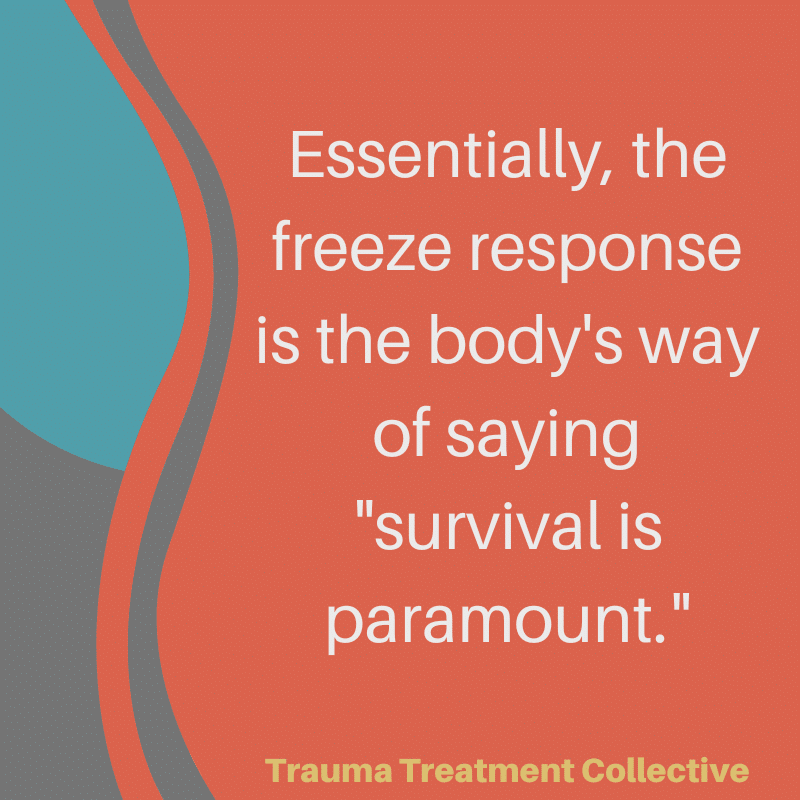In the realm of trauma therapy, the concept of the window of tolerance by Dr. Daniel Siegel serves as a valuable framework for comprehending the multi-faceted responses individuals exhibit when facing distress. Central to this framework is the hypoarousal also known as the freeze response, a survival mechanism that plunges clients into a life preservation state. In this article, we explore the intricacies of the freeze response, the ways to identify it in clients, and effective strategies for helping clients move through it towards healing.
Understanding the Freeze Response
When viewed through the lens of the window of tolerance, the freeze response paints a picture of intense hypoarousal, a state where clients are hyper-focused on survival. Simultaneously, from a nervous system perspective, the parasympathetic nervous system is overactivated, immobilizing the client to conserve energy. Essentially, the freeze response is the body’s way of saying “survival is paramount.” It is the act of immobilization, a strategy for survival or preparing for a perceived threat of death. This state is often described as an analgesic state, a protective mechanism that numbs pain.

Psychoeducation and Defying Stereotypes
Educating clients about the freeze response is pivotal. Often, this state is misunderstood or stigmatized due to societal values that prioritize productivity and movement. An overactive sympathetic reaction might be more socially accepted, but the freeze response’s importance lies in its evolutionary roots as a survival mechanism. By demystifying and validating the freeze response, clients can develop a healthier perspective on their bodily sensations.
Visualizing the Freeze Response
Analogies can be powerful tools in trauma therapy, allowing clients to grasp complex concepts more intuitively. Describing the freeze response as attempting to “blend in with the paint in hopes of danger passing by and everything being okay” helps clients understand its underlying purpose: survival. This visualization validates their response as a natural survival strategy rather than a sign of weakness. I have also heard “the possum response to danger” as a good example of what the freeze response looks like in humans. When I learned about the possum response in the context of defense responses, it gave a whole new meaning to the statement “playing possum.”
Tracking and Noticing the Freeze Response
Identifying the freeze response in clients can be a nuanced process. Common responses include heaviness, lethargy, feeling cold or icy, disconnection, limpness or rigidity in body parts, and low muscle tone. Clients may report these sensations or feelings, or they may be observed externally. Encouraging clients to be curious about these sensations and labeling them as part of the freeze response can increase their awareness about how freeze shows up in everyday life.
Navigating Freeze Through Daily Experiences
Helping clients recognize freeze responses in daily, less intense situations can be a stepping stone towards addressing deeper trauma. As clients gain confidence in navigating smaller triggers, they become better equipped to handle the freeze response triggered by more significant issues. This approach fosters a sense of empowerment, allowing clients to interrupt the freeze response pattern before it becomes overwhelming. Clients are usually surprised to see how often they are engaging in the freeze response in their daily life.

Strategies for Eliciting Movement
Two strategies prove beneficial in helping clients shift out of the freeze response. First, understanding the underlying fear and identifying the associated needs can help release the immobility and create space for mobility. Second, embracing the freeze state and allowing clients to explore it without pressure to move forward can lead to the emergence of hidden emotions, movements, and sensations.
Using Imagination for Movement
To address the apprehension of physically moving in the freeze state, imagination proves to be a powerful tool. Clients can be encouraged to visualize desired movements – observing the resulting changes in their emotions, sensations, images, or thoughts. This technique offers a less overwhelming approach to reconnecting with their bodies.
More resources for working with the Freeze Response
If you would like to grow in your knowledge of the freeze response and how to work with clients, please reach out to us.

Conclusion
Trauma treatment professionals play a crucial role in guiding clients through the intricate journey of the freeze response. By understanding its survival origins, using analogies to demystify it, and employing strategies to notice, address, and move through it; therapists empower clients to embrace their responses with self-compassion. Psychoeducation and patience are key, as clients learn to differentiate between survival mode and the potential for mobility. In this collaborative effort, clients can find renewed hope, healing, and a deeper connection with themselves.

